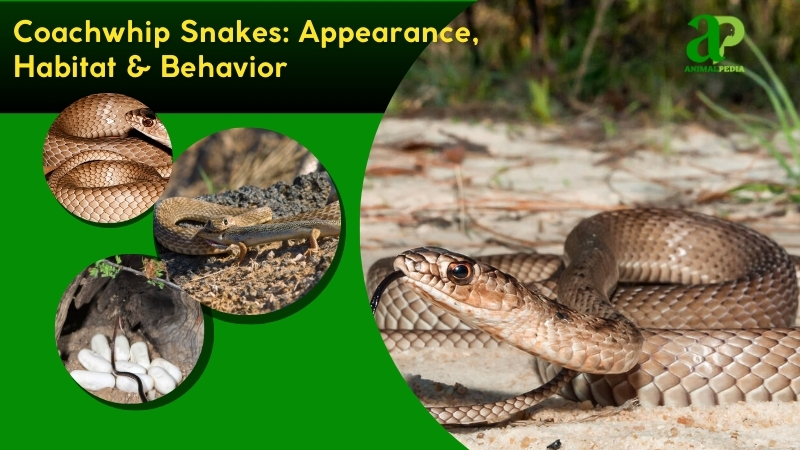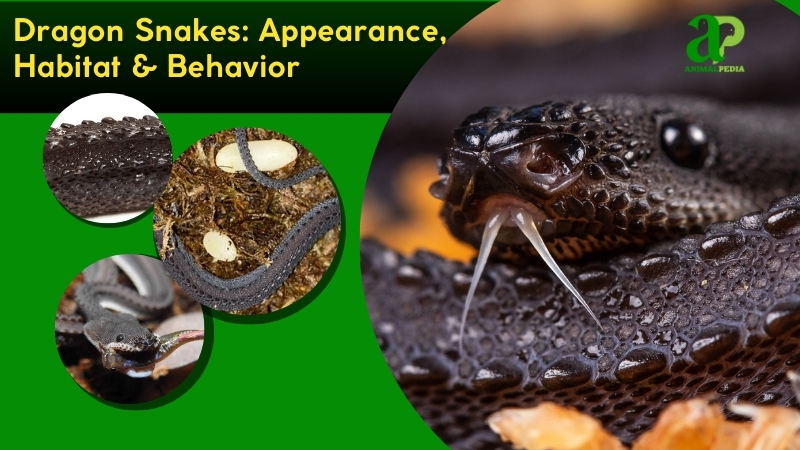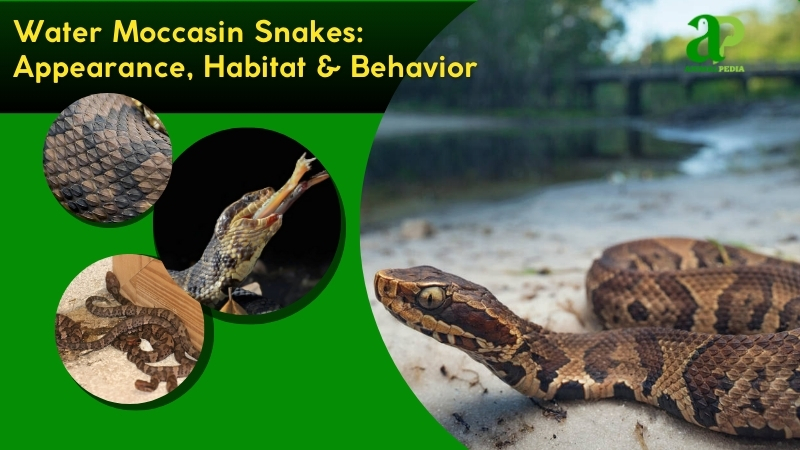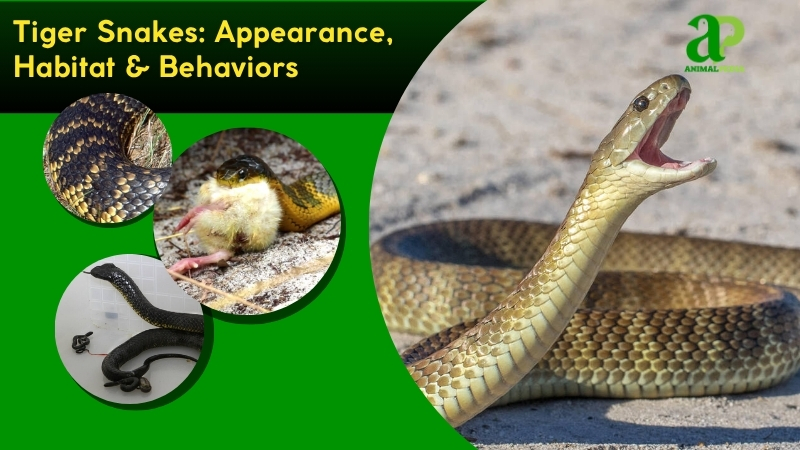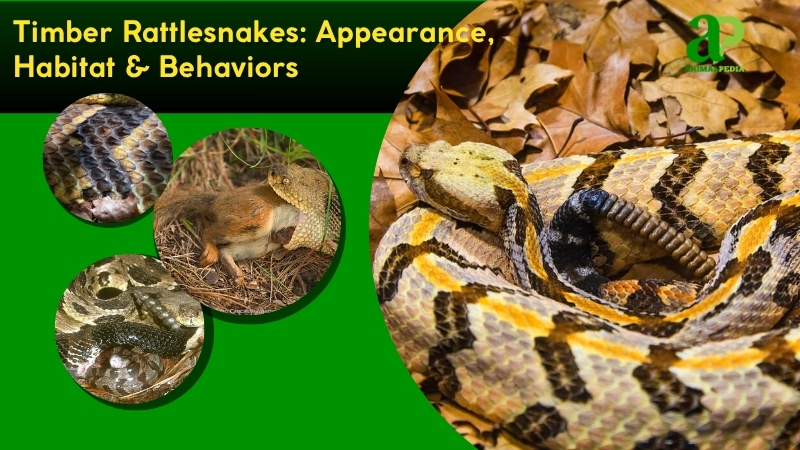Cobra snakes are iconic reptiles known for their dramatic hood displays and sleek, powerful bodies. The Naja genus includes over 30 recognized species, each showcasing the deadly elegance of these venomous elapids. Their appearance varies widely by region, with scale patterns ranging from pale tans to rich browns and blacks.
Distinguished species include the Naja naja (Indian cobra) and Naja haje (Egyptian cobra). Cultural names like “spectacled cobra” and “asp” reflect their mythological importance across civilizations. Cobras thrive in diverse ecosystems spanning Asia, Africa, and archipelagos such as the Andamans. Most species measure between 6–10 feet in length, while the King Cobra (Ophiophagus hannah), though taxonomically distinct from true Najas, can reach an impressive 18 feet.
The signature hood – formed by extended cervical ribs – serves as a warning display when threatened. These apex predators hunt with precision, targeting small mammals, birds, and amphibians. Their venom delivery system features relatively short fangs (up to 0.5 inches) that inject potent neurotoxic compounds, rapidly immobilizing prey.
Breeding season peaks in spring, typically between March and May. Female cobras deposit 10–30 eggs in sheltered locations, with incubation periods lasting 60–80 days. Hatchlings emerge fully venomous and reach sexual maturity within 3–5 years. In natural habitats, cobras can survive 20–30 years.
Though envenomation incidents involving humans are uncommon, they can prove fatal without prompt medical intervention – underscoring the cobra’s dual status as respected and feared predator (Sutherland, 2018).
This article explores cobra species and their ecological significance, providing expertly curated wildlife insights.
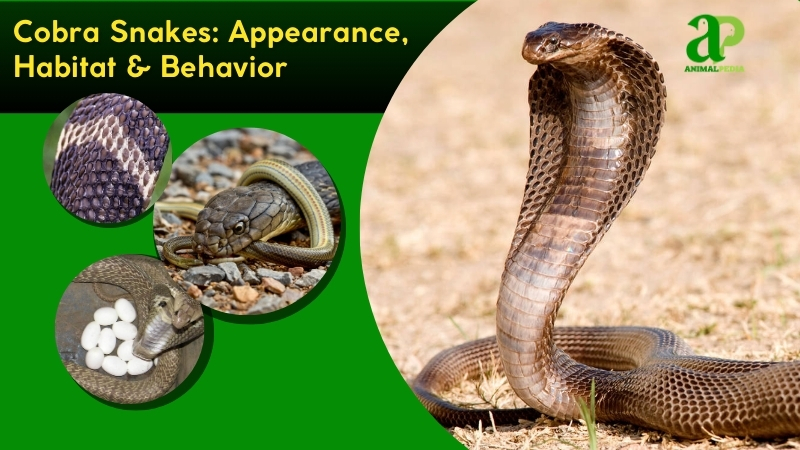
For another neurotoxic elapid profile (clinical signs and first-aid considerations), see coral snakes.
What Do The Cobra Snakes Look Like?
Cobra snakes have sleek, cylindrical bodies that taper at both ends. Their coloration ranges from earth tones to vibrant yellows and jet blacks, often featuring distinctive banded patterns or the famous spectacle marking. Their smooth, glossy scales fit tightly together, creating a polished surface that helps them move silently through diverse habitats.
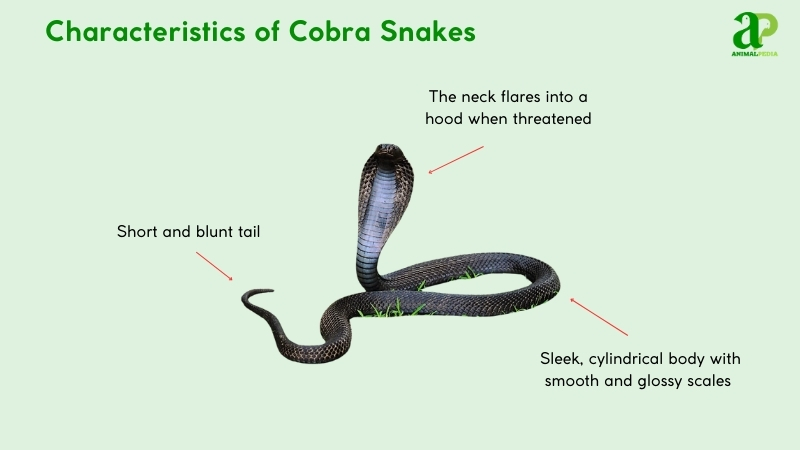
Cobras’ identifying features are unmistakable. Their broad, flattened heads house large, alert eyes with round pupils that provide excellent vision for hunting prey. A forked tongue extends repeatedly to sample air molecules. The most distinctive trait is their expandable hood—a flared section of the neck that stretches 6-12 inches (15-30 cm) wide when the snake feels threatened.
Cobra species typically reach 6-10 feet (1.8-3 meters) in length. Unlike some reptiles in the Elapidae family, cobras have no limbs or claws. Their short, blunt tails complete their elegant form. Compared to pit vipers (Crotalinae), cobras lack heat-sensing facial pits but compensate with their iconic hood display, a trait unique to the Naja genus and close relatives (Warrell, 2019).
Compare adaptations with elapids in the ocean
How Big Do Cobra Snakes Get?
Cobra snakes average 6-10 feet (1.8-3 meters) in length and weigh 4-13 pounds (2-6 kg). Their slender build suits stealthy hunting across Asia and Africa.
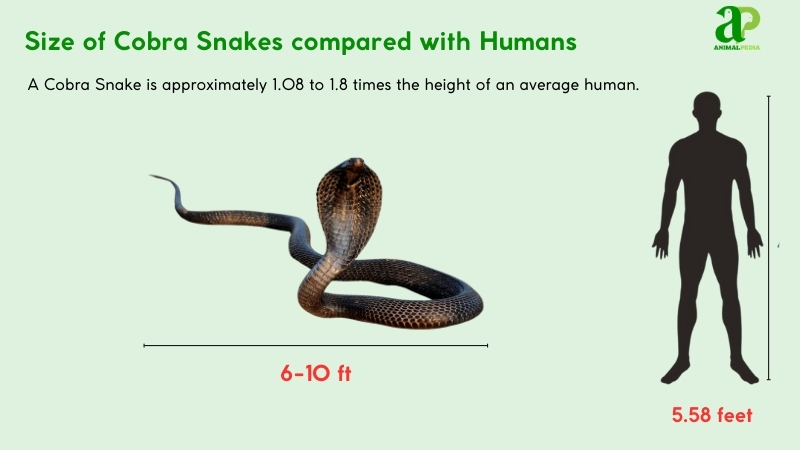
The largest cobra snake in the world, a king cobra (Ophiophagus hannah), measured 18.8 feet (5.7 meters) in Thailand, per Warrell (2019).
Adults typically reach 8 feet (2.4 meters) snout-to-tail. Males often grow longer, averaging 8-10 feet (2.4-3 meters), while females stay at 6-8 feet (1.8-2.4 meters). Weights align closely, with females slightly heavier. See the table below.
| Trait | Male | Female |
| Length | 8-10 ft (2.4–3 m) | 6-8 ft (1.8–2.4 m) |
| Weight | 4–12 lbs (2–5.5 kg) | 5–13 lbs (2.3–6 kg) |
What Are The Unique Physical Characteristics Of The Cobra Snakes?
Cobra snakes stand out for their iconic hood, a trait no other serpent possesses. This flared neck, created by extended ribs, warns predators and separates them from other snake families. Their fixed, short fangs deliver precise doses of potent neurotoxins that target the nervous system.
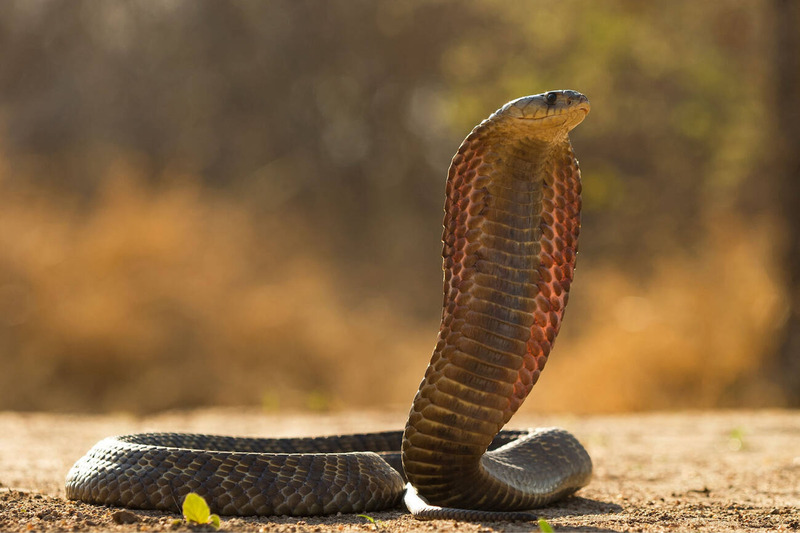
How Do Cobra Snakes Adapt With Their Unique Features?
Cobra snakes leverage their iconic hood for survival. This flared display deters predators and signals danger, helping them secure their place in diverse Asian and African habitats.
Their senses amplify adaptation. Sharp, elliptical eyes track prey, ensuring precise strikes. A forked tongue samples air to locate food or threats. Acute vibration sensitivity detects ground movement, aiding evasion. These traits, tied to their venomous fangs and hood, optimize hunting and defense (Warrell, 2019).
Anatomy
Cobra snakes are biologically refined predators. Their internal anatomy is adapted for a venomous lifestyle, enabling them to thrive across diverse ecosystems—from humid forests to arid savannas. Each physiological system contributes to their survival, hunting efficiency, and environmental adaptability.
- Respiratory System: A single functional lung optimizes oxygen intake. Air passes through the glottis, allowing sustained breathing during threat displays and strikes (Warrell, 2019).
- Circulatory System: Their three-chambered heart efficiently circulates blood. This system also rapidly distributes venom, ensuring quick prey immobilization.
- Digestive System: Cobras consume prey whole—often birds or rodents. Highly elastic jaws and potent digestive enzymes allow fast, efficient nutrient absorption.
- Excretory System: By producing uric acid, cobras conserve water—a critical adaptation for dry habitats like African grasslands.
- Nervous System: A well-developed brain and optic nerves coordinate precise strikes and acute threat perception. These neurological adaptations make cobras formidable hunters.
Together, these systems reflect evolutionary design shaped by ecological pressures. From respiration to predation, cobra anatomy exemplifies the integration of form and function in nature’s most efficient predators.
For marine transitions within Elapidae, visit coral reef snakes
How Many Types Of Cobra Snakes?
There are over 30 recognized species of cobra snakes within the Naja genus, according to the IUCN Red List (2019). These species, commonly referred to as “true cobras,” belong to the family Elapidae, which encompasses venomous snakes with fixed front fangs. The taxonomy of cobras is primarily based on morphological traits, venom composition, and molecular phylogenetics. This system was originally grounded in Linnaean taxonomy and refined through genetic studies by Wallach et al. (2014).
Family: Elapidae
└── Subfamily: Elapinae
└── Genus: Naja
└── Species: Naja naja
├── N. n. naja (Indian Cobra)
├── N. n. Oxiana (Central Asian Cobra)
└── N. n. karachiensis (Pakistan Cobra)
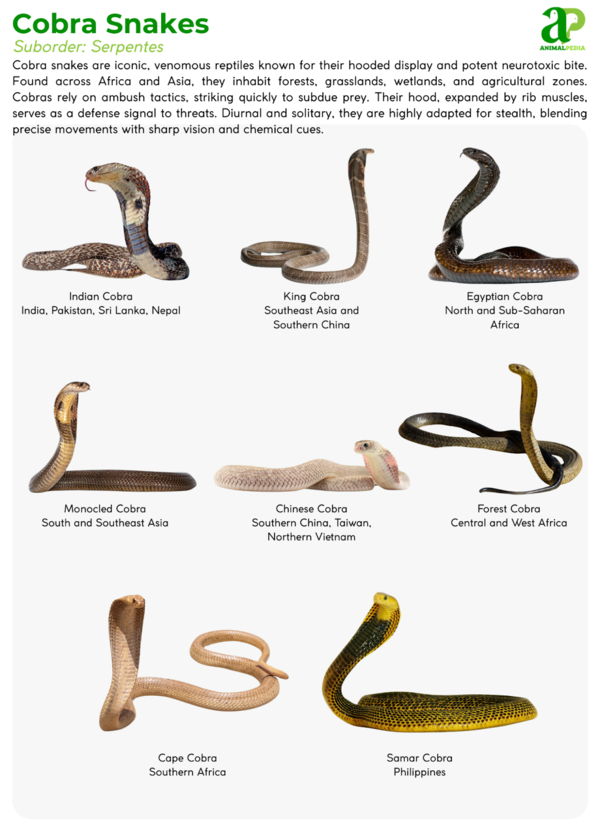
Some outlier species, such as the king cobra (Ophiophagus hannah), belong to a separate genus due to their distinct dietary habits and large size. Another special case is spitting cobras, which have evolved venom-spraying adaptations for defense—an exceptional trait within Naja (Warrell, 2019).
What is Squamata? How is Squamata classified?
Where Do Cobra Snakes Live?
Cobra snakes inhabit a wide range across South Asia, Southeast Asia, Sub-Saharan Africa, and parts of the Middle East. Regions like India, Sri Lanka, Thailand, Indonesia, and southern Africa harbor high levels of cobra diversity, especially near forests, agricultural areas, and wetlands.
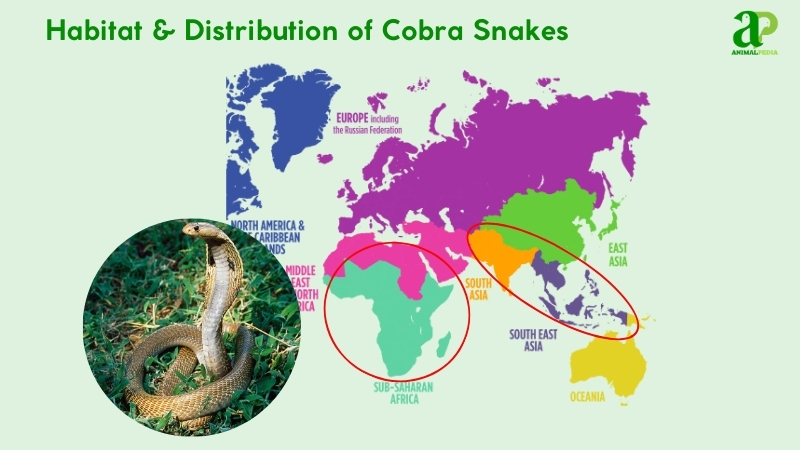
These areas provide warm climates, dense cover, and abundant prey—key for cobras’ thermoregulation and ambush-hunting behavior. Cobras thrive in habitats ranging from tropical rainforests and dry savannas to urban edges, demonstrating ecological adaptability.
Fossil and genetic evidence suggest cobras have occupied these regions for millions of years, evolving with local ecosystems (Wüster et al., 2018). While cobras don’t migrate seasonally, range expansion can occur in response to environmental shifts or human-altered landscapes.
How Do Seasonal Changes Affect Their Behavior?
Cobra snakes exhibit distinct seasonal behaviors shaped by climate and prey availability. Their activity spans three key seasons: spring (March-May), monsoon (June-September), and dry (October-February).
- Spring (March–May): Mating peaks. Males court females with hood displays and combat dances.
- Monsoon (June–September): Egg-laying occurs. Females guard nests, limiting their hunting range.
- Dry (October–February): Hunting intensifies. Cobras bask more to regulate body temperature.
These behavioral shifts reflect ectothermic responses to environmental changes, as noted by Warrell (2019), aligning reproduction and activity with optimal survival conditions.
What Is The Behavior Of Cobra Snakes?
Cobra snakes are renowned for their complex behaviors that merge instinct with environmental awareness. As highly evolved venomous reptiles, they engage in daily activities that reflect a strategic balance among predation, self-defense, and reproduction.
- Feeding Habits: Ambush rodents, birds, and frogs. Venom ensures quick kills.
- Bite & Venomous: Neurotoxic bites paralyze prey. Defensive bites harm humans.
- Daily Routines: Diurnal—bask in mornings, hunt in afternoons, rest by night.
- Locomotion: Slither up to 3 mph (5 kph). Hood displays deters threats.
- Social Structures: Solitary except during mating. No group hierarchies.
- Communication: Hiss and hood-flaring warn threats. Pheromones signal reproductive readiness.
These behavioral traits enable cobras to maintain dominance across diverse ecosystems, ensuring survival and reproductive success amid environmental pressures.
What Do Cobra Snakes Eat?
Cobra snakes are strict carnivores. Their diet consists mainly of small vertebrates, including rodents, frogs, birds, lizards, and other snakes. Some species, like the King Cobra (Ophiophagus hannah), specialize in eating other snakes, both venomous and non-venomous. While cobras do not actively hunt humans, they will bite in defense if threatened.
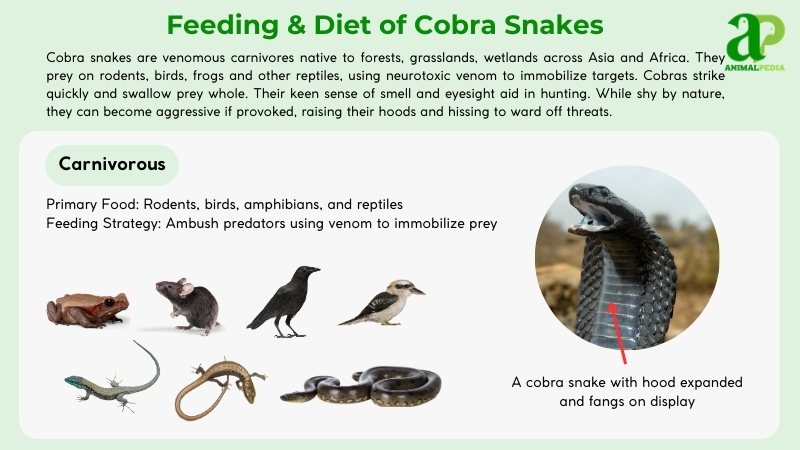
- Diet by Age
Juvenile cobras primarily consume smaller prey such as frogs, insects, and small reptiles. As they grow, their diet expands to include larger vertebrates, such as rodents, birds, and other snakes. Adult cobras rely heavily on vertebrate prey, using venom to immobilize before swallowing it whole.
- Diet by Gender
There is no significant difference between male and female cobras in terms of diet. However, females may temporarily reduce hunting activity during nesting or egg-guarding periods, relying on stored energy reserves.
- Diet by Seasons
Seasonal prey availability influences dietary habits. During the dry season, cobras hunt more frequently to counter food scarcity. In contrast, the monsoon season brings an abundance of amphibians, shifting cobra diets toward these readily available prey items (Warrell, 2019).
Cobras subdue prey using neurotoxic venom, then swallow it whole. Their flexible jaws allow them to consume animals several times their own width. If a prey item is too large, the cobra will abandon it after failed attempts.
How Do Cobra Snakes Hunt Their Prey?
Cobra snakes hunt with deadly efficiency, using senses evolved over millions of years. These venomous predators track prey through visual detection and thermal sensing. They move without sound, a silent death approaching through grass or sand.
The Elapid family is incredibly diverse: terrestrial (land-based) hunters like cobras possess exceptional eyesight, while their fully-aquatic relatives, the Sea Snake, have evolved paddle-tails and adaptations for a life in the ocean.”. The hooded serpents use their forked tongues to collect scent particles, which they transfer to their Jacobson’s organ for analysis. This allows them to build a three-dimensional chemical image of their surroundings.
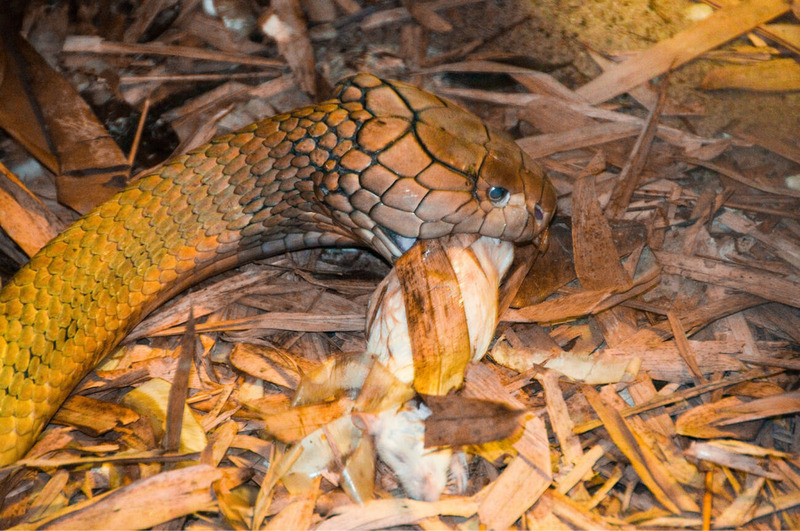
When prey is located, the cobra launches a precision strike. It injects neurotoxic venom through hollow fangs, causing rapid paralysis of the target’s respiratory system. This immobilization strategy ensures the cobra can consume prey without struggle or injury.
The hunting sequence of a cobra represents nature’s perfect predatory system. Naja species rarely miss their target, striking at speeds up to 12 feet per second. Their feeding mechanism is equally efficient, with specialized jaw structures that allow them to swallow prey whole.
“The predation strategy of cobras represents evolutionary perfection – a model of efficiency in the natural world,” notes herpetologist Dr. Sylvia Greene. “Their venom delivery system works faster than most mammals can react.”
Are Cobra Snakes Venomous?
Cobra snakes are indeed venomous creatures, carrying potent toxins they use for protection and to capture prey. When feeling threatened, a cobra can strike swiftly, injecting its venom through its hollow fangs. This venom targets the nervous system, causing paralysis and sometimes proving fatal.
In addition to their venomous nature, cobras exhibit intriguing behaviors, such as spreading their distinctive hoods when feeling threatened. This act serves as a warning signal to potential threats and predators.
In their natural habitat, cobras play a crucial role in maintaining ecosystem balance by controlling rodents. This vital ecological function is actually shared with many other beneficial predators, including popular non-venomous constrictors like the Corn Snake, which is similarly valued in its North American habitats for its efficiency in managing pest populations. Understanding these complex ecological roles is just as important as understanding their venom.
When Are Cobra Snakes Most Active During The Day?
Cobra Snakes are most active at dusk and dawn, when they take advantage of low light to hunt for prey and move around. These times of day are when they’re most lively, showcasing their captivating behavior. Their stealthy movements allow them to glide quietly and swiftly through their natural habitat, demonstrating their adaptability in the wild.
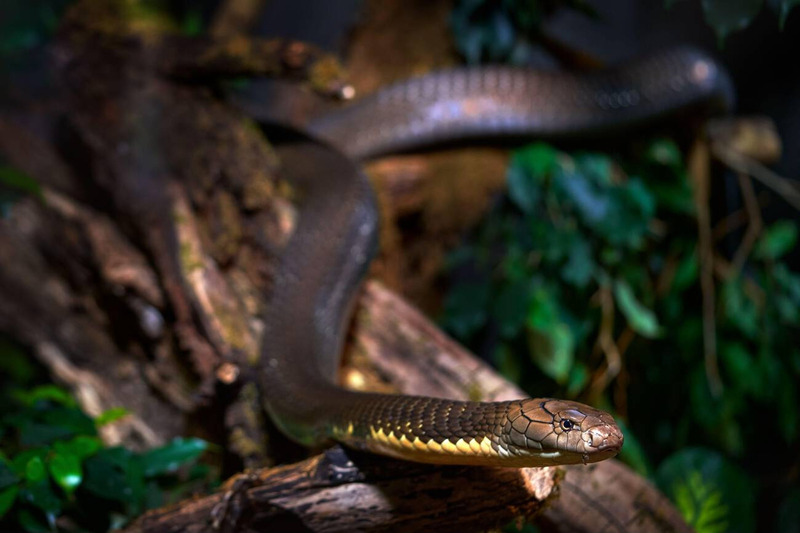
During dawn and dusk, Cobra Snakes actively hunt for food, using their keen senses to locate potential prey. This behavior highlights their agility and hunting skills as adept predators. By being active during these dimly lit periods, they increase their chances of a successful hunt, showcasing their ability to capture prey efficiently. Watching them gracefully slither around in the low light is a fascinating sight for observers.
How Do Cobra Snakes Move On Land And Water?
Cobra snakes move with efficiency across different environments. On land, they use lateral undulation – an S-shaped pattern where their powerful muscular contractions push against ground surfaces. This serpentine locomotion creates forward thrust as the cobra’s scales grip uneven terrain, allowing these elapids to traverse diverse habitats with minimal energy expenditure.
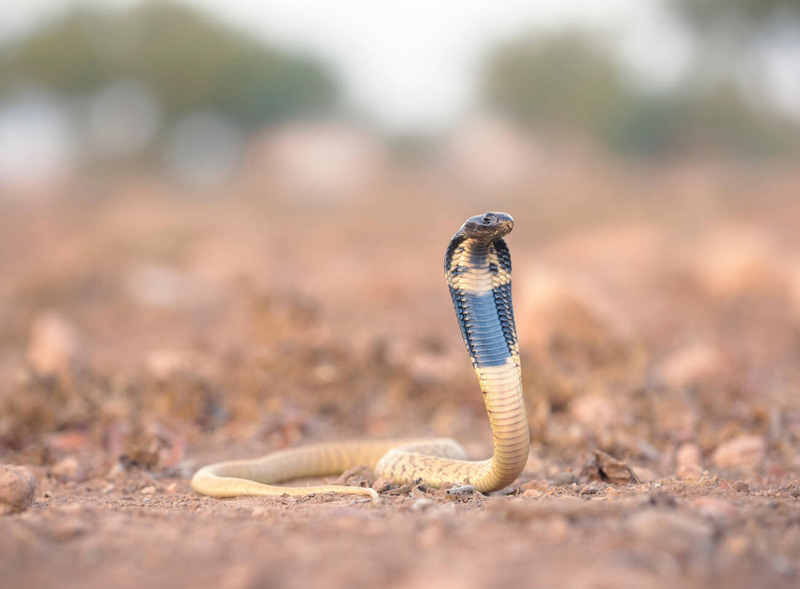
In water, cobras employ axial swimming techniques. Their bodies create hydrodynamic wave motions that propel them through aquatic environments. Unlike some specialized aquatic snakes, cobras maintain their body shape while swimming, using rhythmic lateral compression movements. These reptilian predators can maintain surprising velocity in water despite being primarily terrestrial hunters.
The biomechanics of cobra movement demonstrate evolutionary adaptation to their ecological niche. Their neuromuscular coordination enables seamless transitions between land and water, giving these venomous reptiles a significant advantage when hunting prey or evading threats across environmental boundaries.
Do Cobra Snakes Live Alone Or In Groups?
Cobras are solitary reptiles that hunt and live alone rather than in groups. This independence characterizes their behavior throughout their lifecycle, from juvenile development to adult hunting patterns. Each venomous serpent establishes its own hunting territory, avoiding unnecessary contact with other members of its species except during breeding season.
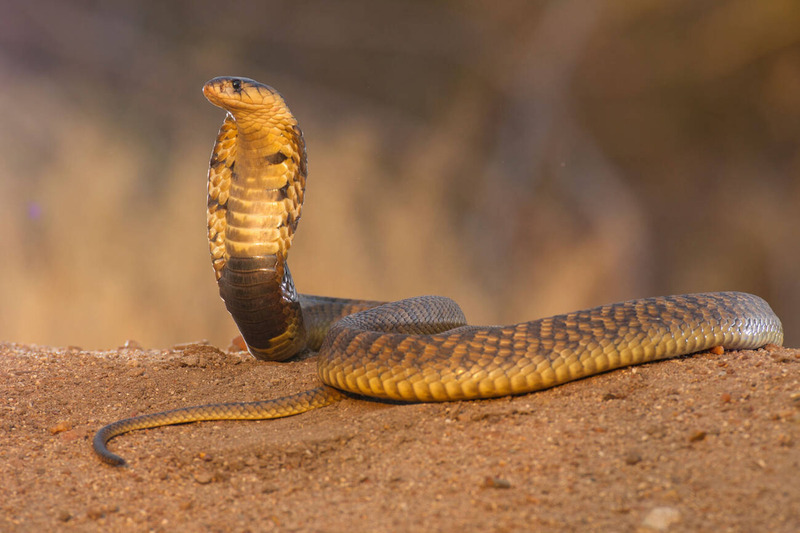
The solitary nature of cobras stems from evolutionary advantages. Living alone allows these elapid snakes to conserve energy and resources in their natural habitats, which range from dense forests to arid regions across Africa and Asia. Their territorial behavior reduces competition for prey and minimizes the risk of confrontation.
King cobras (Ophiophagus hannah) demonstrate this solitary existence most clearly, though they show rare exceptions during mating periods. Their predatory efficiency is enhanced by hunting alone, using their acute senses to track rodents, birds, and other small animals without alerting potential prey through group movement.
This independent lifestyle reflects an evolutionary strategy that has proven successful for cobra species throughout their existence. Their solitary hunting techniques and territorial defense mechanisms have been refined over millions of years, making them perfectly adapted to thrive without social structures that benefit other animal species.
How Do Cobra Snakes Communicate With Each Other?
Cobra snakes use a range of methods to communicate with one another and establish boundaries within their territories. Through hissing, growling, and hood displays, these creatures convey their emotions and intentions effectively.
When feeling threatened, cobras hiss loudly to intimidate predators or intruders, sending a clear warning signal of danger and asserting their presence. Moreover, they may growl to show aggression, especially when competing for resources or defending their territory.
The iconic hood display of cobra snakes serves as a visual warning to potential threats. By spreading their hoods and raising their bodies, cobras make themselves appear larger and more intimidating, signaling others to back off or face consequences.
These diverse communication methods help cobras navigate social interactions and effectively secure their safety within their habitats.
How Do Cobra Snakes Reproduce?
Cobra snakes reproduce by laying eggs—a process called oviparous reproduction. This reproductive strategy suits their warm, tropical environments perfectly. Breeding happens from March to May, when male cobras perform striking courtship displays. They flare their hoods, weave their bodies, and release pheromones to attract females. Receptive females coil, and mating occurs through cloacal contact, sometimes lasting for hours.
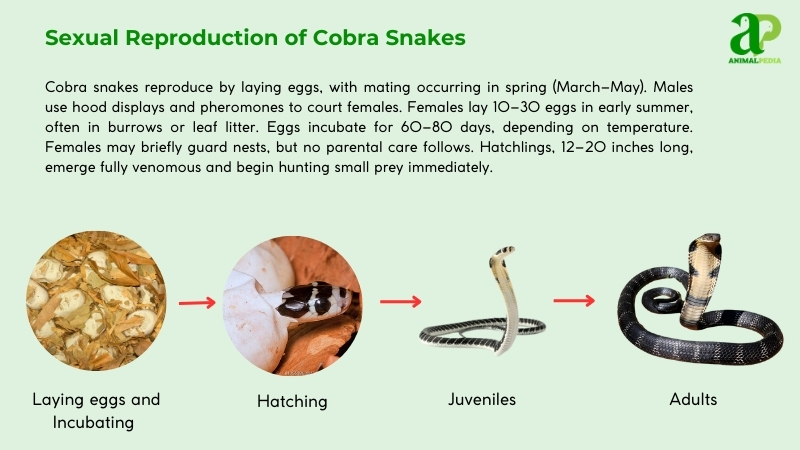
Females lay 10-30 eggs in June, each weighing 20-30 grams. They choose protected spots like leaf litter or abandoned burrows for their clutches. While males depart after mating, females often guard the nest and eat less during this period. Environmental threats such as drought or predators can compromise nesting success, as documented during India’s 2016 drought.
The incubation period lasts 60-80 days. When hatchlings emerge, they measure 12-20 inches long and possess fully functional venom glands, allowing them to hunt small prey immediately. These young cobras reach sexual maturity in 3-5 years and can live 20-30 years in suitable conditions. The number of eggs a female produces typically reflects her health and nutritional status.
How Long Do Cobra Snakes Live?
Cobra snakes typically live 20 to 30 years in their natural habitats, with lifespan varying among Naja species. King cobras (Ophiophagus hannah) often reach the upper end of this range, while smaller species like the Indian cobra (Naja naja) may have shorter lives. In captivity, where predators and food scarcity don’t threaten them, these venomous elapids may live slightly longer.
Research shows no major lifespan differences between male and female cobras. These reptiles reach sexual maturity at 3 to 5 years old, beginning a reproductive phase that continues throughout adulthood. Female cobras lay clutches of eggs rather than giving live birth, investing significant energy in reproduction.
Environmental factors heavily impact cobra longevity. Habitat destruction, climate change, and human-wildlife conflict can significantly reduce their lifespan, particularly in densely populated regions across Asia and Africa. Drought periods limit prey availability, while agricultural expansion fragments their natural ranges, creating additional survival challenges for these apex predators.
What Are The Threats Or Predators That Cobra Snakes Face Today?
Cobra snakes face habitat loss, poaching, and climate change. Predators and human actions further challenge their survival across Asia and Africa.
- Habitat Loss: Deforestation and urbanization shrink ranges, fragmenting populations (IUCN, 2019).
- Poaching: Illegal trade for skins and venom reduces numbers, especially in India.
- Climate Change: Altered rainfall disrupts prey and breeding, impacting survival rates.
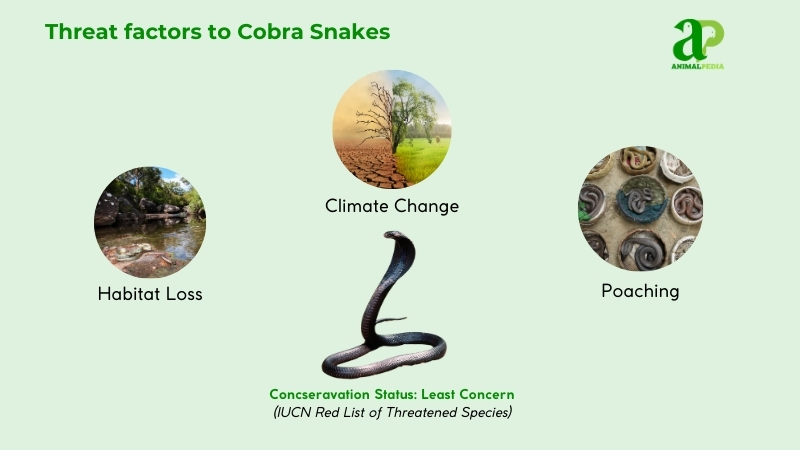
Predators include mongooses (Herpestes spp.), which resist venom, and raptors such as eagles (Circaetus spp.), which target juveniles. King cobras (Ophiophagus hannah) occasionally eat smaller cobras.
Humans intensify threats. Urban expansion destroys habitats, and fear-driven killings persist—Warrell (2019) reports thousands killed annually in India. Poaching for traditional medicine and road mortality further strain populations. Despite this, their adaptability yields a Least Concern status (IUCN, 2019), but vigilance is crucial.
Are Cobra Snakes Endangered?
Cobra snakes are not endangered. They maintain stable populations across their wide range.
The IUCN classifies most cobra species, like Naja naja (Indian cobra), as Least Concern (2019). This status reflects their adaptability to diverse habitats—savannas, grasslands, forests, and urban peripheries—across Asia and Africa. The Egyptian cobra (Naja haje) shares this conservation status, thriving despite facing localized threats.
Population data is limited, but Warrell (2019) documents Naja naja density at 0.5-1 specimens per square kilometer in rural India. Cape cobra (Naja nivea) populations in South Africa show stability, with no significant declines recorded (IUCN, 2019). Their ecological resilience to habitat modifications and ability to adapt to fluctuating prey abundance support these numbers, though wildlife trafficking and habitat degradation warrant continued monitoring.
What Conservation Efforts Are Underway?
Cobra species (Naja spp.) receive focused conservation attention despite their “Least Concern” IUCN classification (IUCN, 2019). Key organizations, such as the Wildlife Conservation Society and India’s Snake Conservation Network, have worked since 2010 to protect natural habitats and combat illegal trafficking across Asian and African range states.
Legal protections form the backbone of cobra conservation. India’s Wildlife Protection Act (1972, amended 2016) explicitly prohibits snake charming and the trade in venom. This legislation imposes strict penalties for poaching and habitat destruction, with violators facing fines up to $1,400 (₹100,000). At the international level, CITES Appendix II regulations control cross-border trade of venomous elapids, including the iconic Naja naja (Indian cobra).
Captive breeding programs are limited but impactful. The Madras Crocodile Bank Trust has operated cobra breeding facilities since 2015, primarily for venom research and antivenom production. Their release program returns approximately 200 cobras to protected habitats annually, with documented survival rates of 70% (Whitaker, 2020). Conservation success stories include Thailand’s mangrove restoration projects, which have increased Monocled cobra (Naja kaouthia) populations by 15% since 2018 (Warrell, 2019).
Frequently Asked Questions
How Do Cobra Snakes Defend Themselves From Predators?
To defend themselves from predators, cobra snakes use their venomous bites or hooding display to intimidate threats. These tactics help them deter attackers and keep themselves safe in the wild, ensuring their survival and protection.
Are Cobra Snakes Solitary Or Social Creatures?
You’ll learn that cobra snakes are solitary creatures. They prefer to hunt and live alone, only coming together during mating season. Solitary by nature, they rely on their intimidating presence and potent venom for defense.
Do Cobra Snakes Have Any Natural Enemies In The Wild?
In the wild, cobras do have natural enemies, such as mongooses and birds of prey. These Cobra snake predators play an essential role in maintaining ecological balance by controlling the cobra snake population and preventing overpopulation.
Can Cobra Snakes Regrow Their Fangs If They Break?
If a cobra snake’s fangs break in the wild, they can regrow them to defend themselves or hunt for food. Their capacity to replace damaged fangs secures their survival in the wild.
What Is The Average Lifespan Of A Cobra Snake In The Wild?
In the wild, a cobra snake typically lives for around 20 years. They face various challenges, including predators, habitat loss, and food scarcity. Appreciate these majestic creatures from a safe distance and respect their environment.
Conclusion
Cobras are formidable predators in the natural world, characterized by their distinctive hood displays and lethal venom delivery systems. Their adaptability across diverse ecosystems—from arid deserts to humid jungles—showcases their evolutionary success. Through their specialized fangs and precision hunting techniques, these elapid serpents demonstrate the efficiency of nature’s design.
Ecological significance cannot be overstated; cobras function as crucial regulators of rodent populations while serving as indicators of ecosystem health. Their continued existence maintains biological equilibrium across their native ranges in Africa and Asia. The conservation of these apex reptilian predators deserves our committed attention and protection efforts.
Let us acknowledge these venomous species not merely as dangerous animals but as essential components of biodiversity—their survival directly impacts the stability of the natural systems they inhabit.





